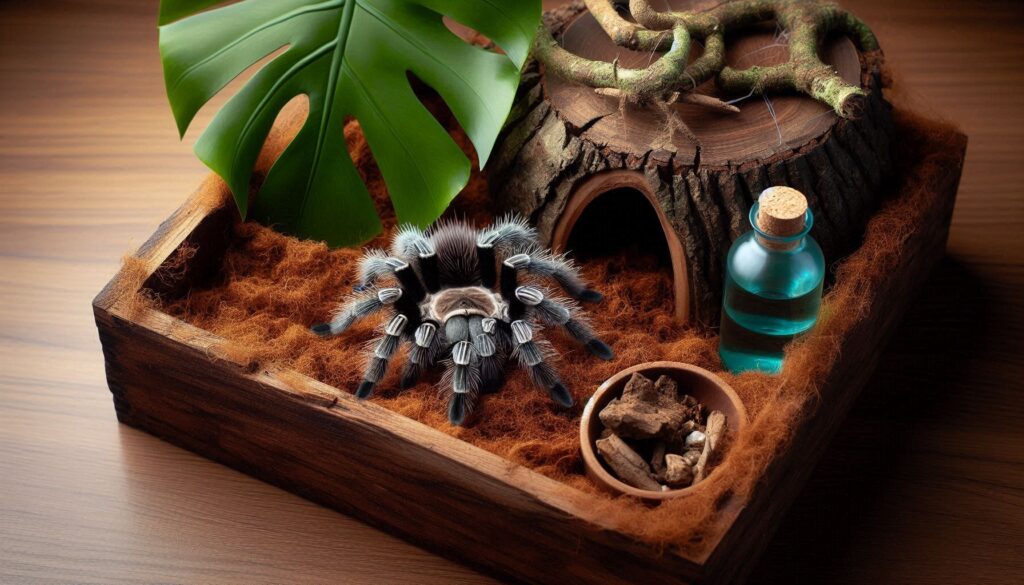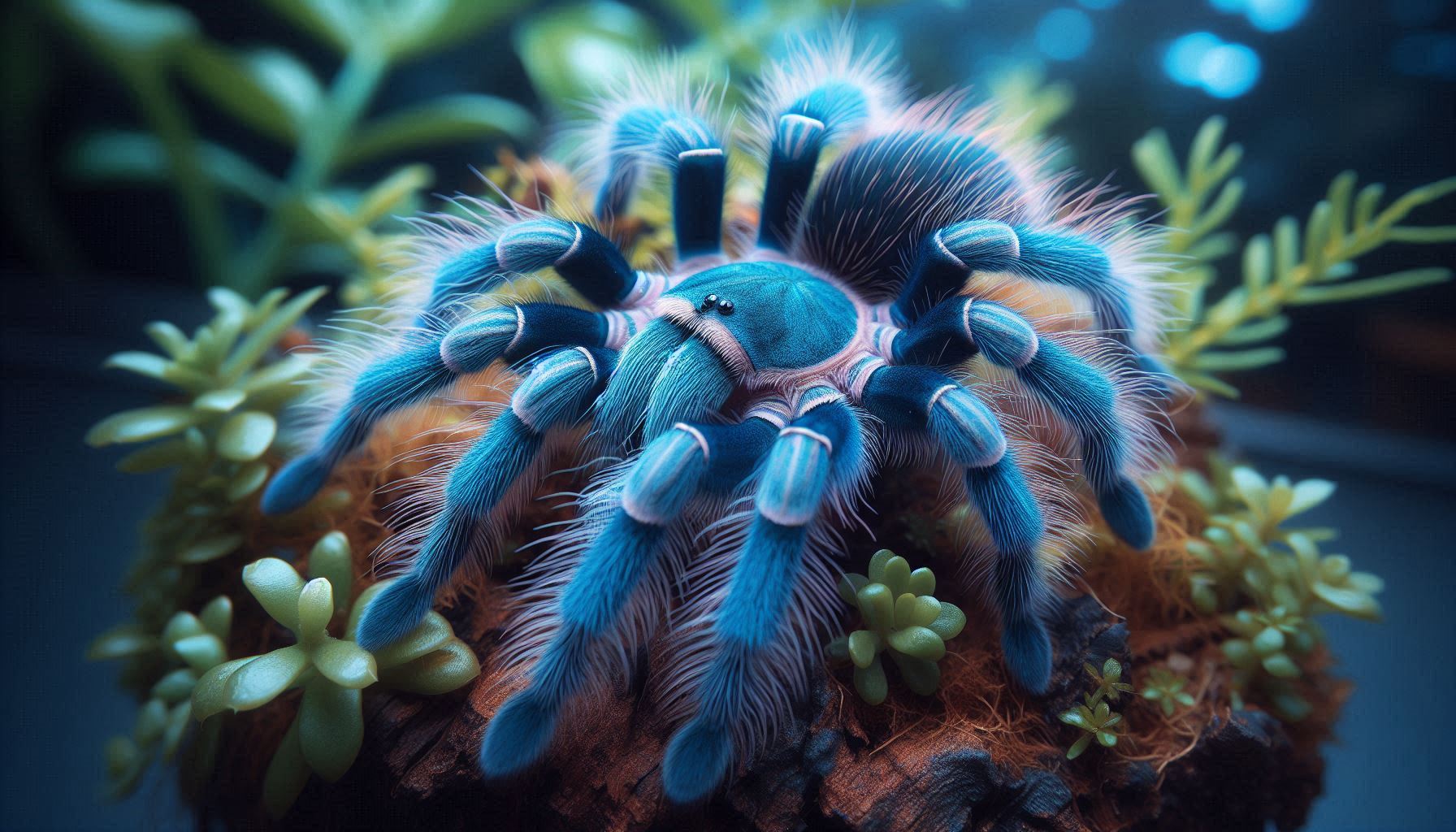Introduction
Table of Contents
The Brazilian Blue Dwarf Tarantula (Ischnocolinae sp. “Brazilian Blue”) is a rare and stunning species of tarantula known for its vibrant blue hue and small size, making it highly sought after by hobbyists and exotic pet enthusiasts. With their bright color, manageable size, and relatively calm nature, Brazilian Blue Dwarfs have become a favorite among tarantula lovers in the USA. However, bringing this remarkable creature into your home requires understanding its care, habitat, and the proper way to buy it. This article covers everything you need to know about the Brazilian Blue Dwarf Tarantula—from habitat requirements to ethical purchasing—to help you make an informed decision and keep your new pet healthy and happy.
Table of Information
| Attribute | Information |
|---|---|
| Scientific Name | Ischnocolinae sp. “Brazilian Blue” |
| Native Habitat | Brazil, South America |
| Size | 2-3 inches in leg span |
| Color | Bright blue with light striping |
| Lifespan | 5-7 years (females longer than males) |
| Temperament | Generally calm but shy |
| Ideal Environment | Humid, with consistent hiding spots |
| Diet | Insects like crickets and roaches |
| Legal Considerations | Verify regulations in your area |
Brazilian Blue Dwarf Tarantula Appearance and Behavior
The Brazilian Blue Dwarf Tarantula is instantly recognizable by its bright blue coloration, which becomes more vibrant under natural or artificial lighting. These tarantulas are classified as “dwarf” due to their small size, which typically reaches between 2 to 3 inches in leg span when fully grown.
While they are generally calm, Brazilian Blue Dwarf Tarantulas can be quite shy and tend to retreat into their hideaways when they feel threatened. Unlike some larger species, they are less aggressive, making them suitable for those who are newer to tarantula ownership. However, they are not “pettable” and should be handled with caution if necessary.
Essential Habitat Setup
Setting up the correct habitat for your Brazilian Blue Dwarf Tarantula is essential to its well-being. Let’s break down the necessary elements:

Enclosure Size and Type
Due to their small size, Brazilian Blue Dwarfs do not require large enclosures. A compact terrarium of about 5 to 10 gallons works well. Look for an enclosure with a secure lid to prevent any escapes.
Substrate
A substrate of coco fiber or peat moss is ideal for maintaining humidity levels and allowing your tarantula to burrow slightly, which they naturally enjoy.
Humidity and Temperature
Aim for humidity levels between 60-75% and temperatures ranging from 70-80°F. This species thrives in a warm, humid environment that mimics the Brazilian rainforest. Daily misting may be required to maintain proper humidity, but avoid over-saturating the substrate.
Lighting and Heating
Avoid direct lighting, as tarantulas are typically more active in low light. While heat lamps are usually not necessary, using a small under-tank heater can be beneficial in cooler climates.
Feeding Your Brazilian Blue Dwarf Tarantula
Brazilian Blue Dwarfs have a typical tarantula diet, primarily consisting of insects. Here’s what you need to know:
Types of Food
These tarantulas enjoy a diet of crickets, roaches, and mealworms. Smaller juveniles may prefer pinhead crickets or other tiny insects, while adults can handle larger food items.
Feeding Schedule
Feed juveniles every 5-7 days, while adults can be fed once every 10-14 days. Remove any uneaten food within 24 hours to prevent mold growth and reduce stress for your tarantula.
Hydration
A small water dish with fresh, clean water is essential. Be sure to change the water frequently and keep it shallow to prevent any accidental drowning.
Purchasing a Brazilian Blue Dwarf Tarantula in the USA
When considering a Brazilian Blue Dwarf Tarantula for sale, it’s important to research breeders and sellers. Ethical sourcing ensures the animal’s health and supports sustainable practices.
Where to Buy
- Reputable Breeders: Look for breeders with positive reviews who specialize in tarantulas.
- Pet Stores: Some pet stores carry exotic tarantulas, but ensure they have knowledgeable staff.
- Online Tarantula Retailers: Many specialized online retailers offer Brazilian Blue Dwarfs for sale. Verify their shipping conditions and return policies.
Price Range
Prices for Brazilian Blue Dwarf Tarantulas typically range from $50 to $100, depending on the size and age. Remember to factor in additional costs for setup, habitat, and ongoing care.
Legal and Ethical Considerations
Before purchasing a Brazilian Blue Dwarf Tarantula, verify the legality in your state or city, as some locations restrict exotic pets. Additionally, consider the ethical implications of purchasing a wild-caught specimen. Opt for a captive-bred tarantula, as these are healthier, more adaptable to captivity, and help reduce pressure on wild populations.
Brazilian Blue Dwarf Tarantula Temperament and Interaction
While not aggressive, Brazilian Blue Dwarf Tarantulas are still wild animals that should be handled sparingly. They may show defensive behavior when frightened but are generally tolerant of mild disturbances.
Health and Lifespan
With proper care, female Brazilian Blue Dwarfs can live up to 7 years, while males usually have a shorter lifespan. Signs of a healthy tarantula include a good appetite, a full abdomen, and a consistent molting cycle.
Common Health Concerns
- Mites: Regularly clean the enclosure to prevent mites.
- Dehydration: Provide a water dish and maintain humidity.
- Injury: Ensure no sharp objects are in the enclosure.
Conclusion
The Brazilian Blue Dwarf Tarantula is a unique and beautiful pet that can bring joy to any arachnid enthusiast. By understanding its habitat needs, diet, and behavior, you can provide a happy, healthy life for this vibrant tarantula. Remember to source your tarantula ethically, create an appropriate enclosure, and enjoy the presence of this fascinating creature in your home!
FAQs about Brazilian Blue Dwarf Tarantulas
- How long do Brazilian Blue Dwarf Tarantulas live?
Females can live up to 7 years, while males typically have shorter lifespans. - What should I feed my Brazilian Blue Dwarf Tarantula?
They enjoy small insects such as crickets, roaches, and mealworms. - Is the Brazilian Blue Dwarf Tarantula aggressive?
They are generally calm but may retreat when disturbed. - Do I need a special permit to own a Brazilian Blue Dwarf Tarantula?
It depends on your local laws; check with local authorities before purchasing. - How much does a Brazilian Blue Dwarf Tarantula cost?
Prices vary, but they typically range between $50 and $100.

